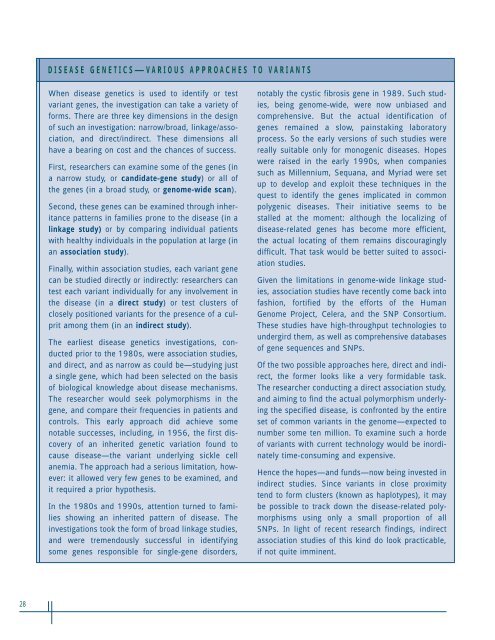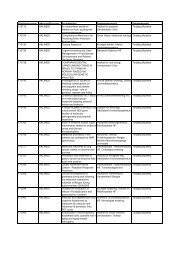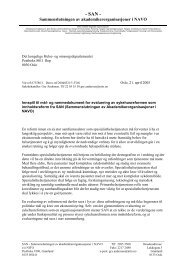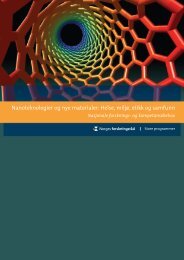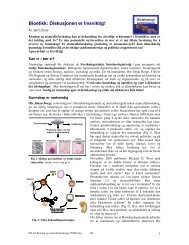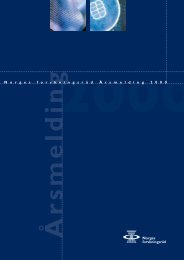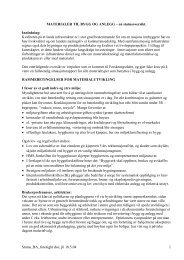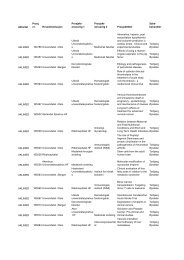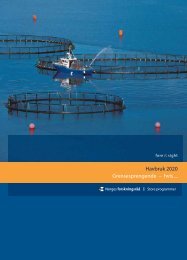A Revolution in R&D
A Revolution in R&D
A Revolution in R&D
Create successful ePaper yourself
Turn your PDF publications into a flip-book with our unique Google optimized e-Paper software.
28<br />
DISEASE GENETICS—VARIOUS APPROACHES TO VARIANTS<br />
When disease genetics is used to identify or test<br />
variant genes, the <strong>in</strong>vestigation can take a variety of<br />
forms. There are three key dimensions <strong>in</strong> the design<br />
of such an <strong>in</strong>vestigation: narrow/broad, l<strong>in</strong>kage/association,<br />
and direct/<strong>in</strong>direct. These dimensions all<br />
have a bear<strong>in</strong>g on cost and the chances of success.<br />
First, researchers can exam<strong>in</strong>e some of the genes (<strong>in</strong><br />
a narrow study, or candidate-gene study) or all of<br />
the genes (<strong>in</strong> a broad study, or genome-wide scan).<br />
Second, these genes can be exam<strong>in</strong>ed through <strong>in</strong>heritance<br />
patterns <strong>in</strong> families prone to the disease (<strong>in</strong> a<br />
l<strong>in</strong>kage study) or by compar<strong>in</strong>g <strong>in</strong>dividual patients<br />
with healthy <strong>in</strong>dividuals <strong>in</strong> the population at large (<strong>in</strong><br />
an association study).<br />
F<strong>in</strong>ally, with<strong>in</strong> association studies, each variant gene<br />
can be studied directly or <strong>in</strong>directly: researchers can<br />
test each variant <strong>in</strong>dividually for any <strong>in</strong>volvement <strong>in</strong><br />
the disease (<strong>in</strong> a direct study) or test clusters of<br />
closely positioned variants for the presence of a culprit<br />
among them (<strong>in</strong> an <strong>in</strong>direct study).<br />
The earliest disease genetics <strong>in</strong>vestigations, conducted<br />
prior to the 1980s, were association studies,<br />
and direct, and as narrow as could be—study<strong>in</strong>g just<br />
a s<strong>in</strong>gle gene, which had been selected on the basis<br />
of biological knowledge about disease mechanisms.<br />
The researcher would seek polymorphisms <strong>in</strong> the<br />
gene, and compare their frequencies <strong>in</strong> patients and<br />
controls. This early approach did achieve some<br />
notable successes, <strong>in</strong>clud<strong>in</strong>g, <strong>in</strong> 1956, the first discovery<br />
of an <strong>in</strong>herited genetic variation found to<br />
cause disease—the variant underly<strong>in</strong>g sickle cell<br />
anemia. The approach had a serious limitation, however:<br />
it allowed very few genes to be exam<strong>in</strong>ed, and<br />
it required a prior hypothesis.<br />
In the 1980s and 1990s, attention turned to families<br />
show<strong>in</strong>g an <strong>in</strong>herited pattern of disease. The<br />
<strong>in</strong>vestigations took the form of broad l<strong>in</strong>kage studies,<br />
and were tremendously successful <strong>in</strong> identify<strong>in</strong>g<br />
some genes responsible for s<strong>in</strong>gle-gene disorders,<br />
notably the cystic fibrosis gene <strong>in</strong> 1989. Such studies,<br />
be<strong>in</strong>g genome-wide, were now unbiased and<br />
comprehensive. But the actual identification of<br />
genes rema<strong>in</strong>ed a slow, pa<strong>in</strong>stak<strong>in</strong>g laboratory<br />
process. So the early versions of such studies were<br />
really suitable only for monogenic diseases. Hopes<br />
were raised <strong>in</strong> the early 1990s, when companies<br />
such as Millennium, Sequana, and Myriad were set<br />
up to develop and exploit these techniques <strong>in</strong> the<br />
quest to identify the genes implicated <strong>in</strong> common<br />
polygenic diseases. Their <strong>in</strong>itiative seems to be<br />
stalled at the moment: although the localiz<strong>in</strong>g of<br />
disease-related genes has become more efficient,<br />
the actual locat<strong>in</strong>g of them rema<strong>in</strong>s discourag<strong>in</strong>gly<br />
difficult. That task would be better suited to association<br />
studies.<br />
Given the limitations <strong>in</strong> genome-wide l<strong>in</strong>kage studies,<br />
association studies have recently come back <strong>in</strong>to<br />
fashion, fortified by the efforts of the Human<br />
Genome Project, Celera, and the SNP Consortium.<br />
These studies have high-throughput technologies to<br />
undergird them, as well as comprehensive databases<br />
of gene sequences and SNPs.<br />
Of the two possible approaches here, direct and <strong>in</strong>direct,<br />
the former looks like a very formidable task.<br />
The researcher conduct<strong>in</strong>g a direct association study,<br />
and aim<strong>in</strong>g to f<strong>in</strong>d the actual polymorphism underly<strong>in</strong>g<br />
the specified disease, is confronted by the entire<br />
set of common variants <strong>in</strong> the genome—expected to<br />
number some ten million. To exam<strong>in</strong>e such a horde<br />
of variants with current technology would be <strong>in</strong>ord<strong>in</strong>ately<br />
time-consum<strong>in</strong>g and expensive.<br />
Hence the hopes—and funds—now be<strong>in</strong>g <strong>in</strong>vested <strong>in</strong><br />
<strong>in</strong>direct studies. S<strong>in</strong>ce variants <strong>in</strong> close proximity<br />
tend to form clusters (known as haplotypes), it may<br />
be possible to track down the disease-related polymorphisms<br />
us<strong>in</strong>g only a small proportion of all<br />
SNPs. In light of recent research f<strong>in</strong>d<strong>in</strong>gs, <strong>in</strong>direct<br />
association studies of this k<strong>in</strong>d do look practicable,<br />
if not quite imm<strong>in</strong>ent.


